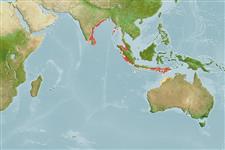>
Blenniiformes (Blennies) >
Blenniidae (Combtooth blennies) > Blenniinae
Etymology: Meiacanthus: Greek, meion = less = lessen + Greek, akantha = thorn (Ref. 45335).
Environment: milieu / climate zone / depth range / distribution range
Οικολογία
Θαλασσινό(ά) βενθικό(ς); εύρος βάθους 1 - 13 m (Ref. 52304). Tropical
Eastern Indian Ocean: known from the type locality, Surin Neur Island, south coast, Phangnga Province, Surin Islands, 9°24'56"N, 97°52'40"E.
Μέγεθος / Βάρος / Age
Maturity: Lm ? range ? - ? cm
Max length : 8.0 cm TL αρσενικό/απροσδιόριστο; (Ref. 90102)
Short description
Κλείδες προσδιορισμού | Μορφολογία | Μορφομετρία
Ραχιαίες άκανθες (συνολικά) : 4 - 5; Μαλακές ραχιαίες ακτίνες (συνολικά) : 22 - 24; Εδρικές άκανθες: 2; Μαλακές εδρικές ακτίνες: 15 - 16; Σπόνδυλοι: 32 - 34. A species of Meiacanthus with dentary glands positioned ventraly and encapsulated in dentary bone; no lateral line; mid-point of supratemporal canal ending in pair of pores; only 2 pores each in mandibular and posttemporal series; posttemporal bone reduced, wedge-shaped without ventral arm; infraorbital bones; and colour pattern characterized by uniformly pale tan body with narrow dark lateral stripe extending from snout to near beginning of bright orange-yellow caudal peduncle, where it is typically interrupted and replaced by elongate black spot.
Adults inhabit coral outcrops, coastal reefs. They occur in small or large groups which may exceed 100 individuals (Ref. 90102). Oviparous. Eggs are demersal and adhesive (Ref. 205), and are attached to the substrate via a filamentous, adhesive pad or pedestal (Ref. 94114). Larvae are planktonic, often found in shallow, coastal waters (Ref. 94114). Mimicked by Cheilodipterus quinquelineatus (Ref. 90102). Minimum depth of 1 m reported from Ref. 90102.
Life cycle and mating behavior
Γεννητική Ωρίμανση | Αναπαραγωγή | Γεννοβολία | Αβγά | Γονιμότητα | Προνύμφες
Oviparous, distinct pairing (Ref. 205).
Eschmeyer, W.N. (ed.), 2003. Catalog of fishes. Updated database version of March 2003. Catalog databases as made available to FishBase in March 2003. (Ref. 46206)
IUCN Red List Status (Ref. 130435: Version 2024-1)
Threat to humans
Harmless
Human uses
Εργαλεία
Special reports
Download XML
Διαδικτυακές πηγές
Estimates based on models
Preferred temperature (Ref.
123201): 28.4 - 29.4, mean 29 °C (based on 162 cells).
Phylogenetic diversity index (Ref.
82804): PD
50 = 0.5000 [Uniqueness, from 0.5 = low to 2.0 = high].
Bayesian length-weight: a=0.00575 (0.00253 - 0.01308), b=3.06 (2.86 - 3.26), in cm total length, based on LWR estimates for this (Sub)family-body shape (Ref.
93245).
Τροφικό Επίπεδο (Ref.
69278): 3.4 ±0.4 se; based on size and trophs of closest relatives
Ελαστικότητα (Ref.
120179): Υψηλό, ελάχιστος χρόνος για διπλασιασμό πληθυσμού < 15 μήνες (Preliminary K or Fecundity.).
Fishing Vulnerability (Ref.
59153): Low vulnerability (10 of 100).
